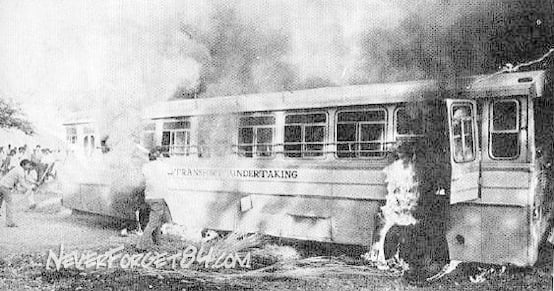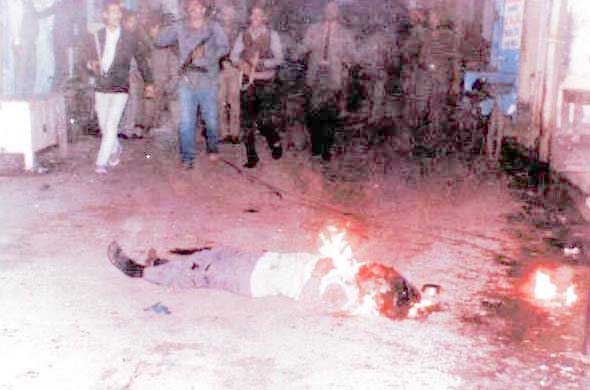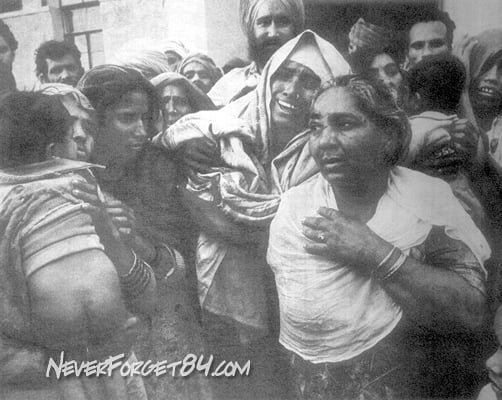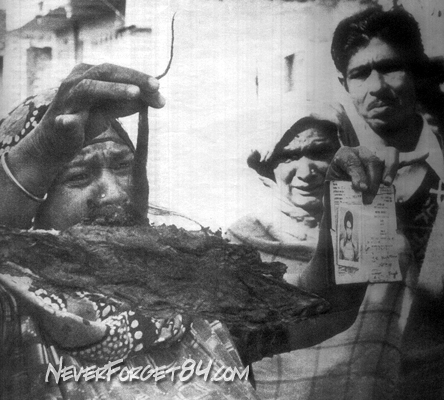1984 Massacre of Sikhs
1984 Anti-Sikh Pogroms took place in India after the assassination of Indira Gandhi on October 31, 1984. India's Prime Minister Indira Gandhi was assassinated by two of her Sikh guards acting in the aftermath of Operation Bluestar.
Over the next four days nearly 3000 Sikhs were massacred in systematic riots planned and led by Congress activists and sympathizers. The then Congress government was widely criticized for doing very little at the time, if not acting as a conspirator, especially since voting lists were used to identify Sikh families.
The then Prime Minister Rajiv Gandhi, son of Indira Gandhi allegedly made a statement emphasizing the importance of his mother, while discounting the death of thousands, "When a big tree falls, the earth is bound to shake" on the Sikh carnage. His widow, Sonia Gandhi, the President of the Congress Party, officially apologized in 1998 for the events of November, 1984.
It is alleged that the anti-Sikh violence were conducted at the behest of the Congress party who actually instigated masses. Many ordinary Indians of different religious dispositions made significant efforts to hide and help Sikh families as outlined in affidavits of Sikh victims and have been active in seeking appropriate justice.
Incident
On November 1, 1984, a huge mob from the suburbs of Delhi descended on various localities where mainly Sikh were concentrated. They were armed with iron rods, knives, clubs and some carried combustible materials, including kerosene. They had voters' lists of houses and business establishments belonging to Sikhs. The mobsters swarmed into Sikh homes brutally killing men, women and children. Their houses and shops were then ransacked and burned. The most affected regions were neighborhoods in Delhi, but in and out of Delhi, crazed mobs stopped buses and trains, pulling out Sikh passengers who were lynched or doused with kerosene and burned alive.
Timeline
9:20 AM: Indira Gandhi shot by two of her sikh security guards at her residence, No. 1 Safdarjung Road, and rushed to All India Institute of Medical Sciences (AIIMS).
Around 10:50 AM: Indira Gandhi dies. [5][6]
11:00 AM: All India Radio listeners learn that two security guards who shot Indira Gandhi were Sikhs.
4:00 PM: Rajiv Gandhi returns from West Bengal and reaches AIIMS. Stray incidents of attacks in and around that area.
5:30 PM: The motorcade of President Zail Singh, who returned from a foreign visit, was stoned as it approached AIIMS. Late Evening and Night: Mobs fanned out in different directions from AIIMS. The violence against Sikhs spread, starting in the neighboring constituency of Congress Councillor Arjun Das. The violence included destruction of Sikh properties and takes place even in VIP areas such as in the vicinity of Prithviraj Road.
Shortly after Rajiv Gandhi was sworn in, senior advocate and opposition leader, Ram Jethmalani, met Home Minister, P.V. Narasimha Rao and urged him to take immediate steps to save Sikhs from further attacks. Delhi's Lt. Governor, P.G. Gavai and Police Commissioner, S.C. Tandon, visited some of the violence affected areas. But no precautionary follow -up action was initiated. It was also alleged that Rajiv Gandhi deliberately delayed in calling in the Army, a move which many believe could have saved the lives of many.
On the night of October 31st and morning of November 1st, several Congress leaders allegedly held meetings and mobilized support to launch a full scale assault against Delhi's Sikhs.

Commission(s) of Enquiry
Numerous commissions have been setup to investigate the pogroms, however, many of the primary accused were acquitted or never charge-sheeted. Ten commissions and committees have till now inquired into the pogroms. The most recent commission on the pogroms, headed by Justice G.T. Nanavati submitted its 185-page report to the Home Minister, Shivraj Patil on February 9, 2005 and the report was tabled in Parliament on August 8, 2005. The commissions below are listed in the order they were formed.
Marwah Commission
This commission was appointed in November 1984. Ved Marwah, Additional Commissioner of Police, was assigned the job of enquiring into the role of the police during the carnage of November 1984. Mr Marwah almost completed his inquiry towards the middle of 1985 when he was directed by the Central Government not to proceed further as Misra Commission had been appointed by then. Complete records of the Marwah Commission were taken over by the government and were later transferred to the Misra Commission. However, the most important part of the record, namely the handwritten notes of Mr Marwah, which contained important information, were not transferred to the Misra Commission.
Misra Commission of Enquiry
Misra commission was appointed in May 1985. Justice Rangnath Misra, was a sitting judge of the Supreme Court of India. Justice Misra submitted his report in August 1986 and the report was made public six months thereafter in February 1987. In his report, Justice Misra stated that it was not part of his terms of reference to identify any person and recommended the formation of three committees. There was only one term of reference to this commission, i.e. whether the violence was organised? The commission and its report has been heavily criticized as biased and a miscarriage of justice.
Kapur Mittal Committee
Kapur Mittal Committee was appointed in February 1987 on the recommendation of the Misra Commission to inquire into the role of the police, which the Marwah Commission had almost completed in 1985 itself, when the government asked that committee to wind up and not proceed further. After almost two years, this committee was appointed for the same purpose. This committee consisted of Justice Dalip Kapur and Mrs Kusum Mittal, retired Secretary of Uttar Pradesh. It submitted its report in 1990. Seventy-two police officers were identified for their connivance or gross negligence. The committee recommended forthwith dismissal of 30 police officers out of 72. However, till date, not a single police officer has been awarded any kind of punishment.
Jain Banerjee Committee
This committee was recommended by the Misra Commission for recommending registration of cases. It consisted of Justice M.L. Jain, former Judge of the Delhi High Court and Mr A.K. Banerjee, retired Inspector General of Police. The Misra Commission held in its report that a large number of cases had not been registered and wherever the victims named political leaders or police officers, cases were not registered against them. This committee recommended registration of cases against Mr Sajjan Kumar in August 1987, but no case was registered. In November 1987 many press reports appeared for not registering cases in spite of the recommendation of the committee. In December 1987, one of the co-accused along with Sajjan Kumar, namely Mr Brahmanand Gupta filed a writ petition in the Delhi High Court and obtained a stay against this committee. The government did not oppose the stay. The Citizens Justice Committee filed an application for vacating the stay. Ultimately, the writ petition was decided in August 1989 and the high court quashed the appointment of this committee. An appeal was filed by the Citizens Justice Committee in the Supreme Court of India.
Potti Rosha Committee
Potti Rosha Committee was appointed in March 1990, by the V.P. Singh government, as a successor to the Jain Banerjee Committee. In August 1990, Potti-Rosha issued recommendations for filing cases based on affidavits victims of the violence had submitted. There was one against Sajjan Kumar. A CBI team went to Kumar's home to file the charges; his supporters locked them up and threatened them harm if they persisted in their designs on their leader. As a result of this intimidation, when Potti-Rosha's term expired in September 1990, Potti and Rosha decided to disband their inquiry.
Jain Aggarwal Committee
The committee was appointed in December 1990 as a successor to the Potti Rosha Committee. It consisted of Justice J.D. Jain, retired Judge of the Delhi High Court and Mr D.K. Aggarwal, retired DGP of Uttar Pradesh. This committee recommended registration of cases against H.K.L. Bhagat, Sajjan Kumar, Dharamdas Shastri and Jagdish Tytler. The Committee also suggested setting up of two - three Special Investigating Teams in the Delhi Police under a Deputy Commissioner of Police and the overall supervision by the Additional Commissioner of Police, In-charge - CID and also to review the work-load of the three Special Courts set up to deal with October - November, 1984 pogroms cases exclusively so that these cases could be taken up on day-to-day basis. The question of appointment of Special Prosecutors to deal with October - November 1984 pogroms cases exclusively was also discussed. This committee was wound up in August 1993. However, the cases recommended by this committee were not even registered by the police.
Ahuja Committee
Ahuja Committee was the third committee recommended by the Misra Commission to ascertain the total number of killings in Delhi. This committee submitted its report in August 1987 and gave a figure of 2,733 as the number of Sikhs killed in Delhi alone.
Dhillon Committee
Dhillon Committee headed by Mr Gurdial Singh Dhillon was appointed in 1985 to recommend measures for the rehabilitation of the victims. This committee submitted its report by the end of 1985. One of the major recommendations of this Committee was that the business establishments, which had insurance cover, but whose insurance claims were not settled by insurance companies on the technical ground that riot was not covered under insurance, should be paid compensation under the directions of the government. This committee recommended that since all insurance companies were nationalised, they be directed to pay the claims. However, the government did not accept this recommendation and as a result insurance claims were rejected by all insurance companies throughout the country.
Narula Committee
Narula Committee was appointed in December 1993 by the Madan Lal Khurana government in Delhi. One of the recommendations of the Narula Committee was to convince the Central Government to grant sanction in this matter. Mr. Khurana took up the matter with the Central Government and in the middle of 1994, the Central Government decided that the matter did not fall within its purview and sent the case to the Lt. Governor of Delhi. It took two years for the Narasimha Rao Government to decide that it did not fall within Centre's purview. Narasimha Rao Government further delayed the case. This committee submitted its report in January 1994 and recommended the registration of cases against H.K.L. Bhagat, Sajjan Kumar and Jagdish Tytler. Ultimately, despite the delay by the Central government, the CBI was able to file the charge sheet in December 1994.
Nanavati Commission was appointed by a unanimous resolution passed in the Rajya Sabha. This commission was headed by Justice G.T. Nanavati, retired Judge of the Supreme Court of India. The commission submitted its report in February 2004. The Commission claimed evidence against congressmen Jagdish Tytler, Sajjan Kumar and H.K.L. Bhagat for instigating the mobs to violence. The Commission also held the then police commissioner S.C. Tandon directly responsible for the pogroms. There was widespread protest against the report as it did not mention clearly the role of Tytler and other Congressmen in the pogroms. It finally led to the resignation of Jagdish Tytler from the Union Cabinet. The Indian Prime Minister Manmohan Singh also apologised to the Sikhs for the pogroms, few days after the report was tabled in the Parliament. The ATR report, while exonerating Mr Tytler, said, "a person cannot be prosecuted simply on the basis of probabilities."
Nearly 3,000 members of India's Sikh community were massacred after the assassination of Prime Minister Indira Gandhi by her two Sikh bodyguards on 31 October 1984. Rahul Bedi, one of the first journalists to reach the affected areas in the capital, Delhi, recalls events. The wave of ethnic cleansing which raged unhindered across the country, especially in Delhi, after Mrs Gandhi was shot dead ended only with her cremation on 2 November. During these three days droves of Sikhs were determinedly hunted down by Hindu mobs from their homes, corralled and slaughtered like animals. The trigger for Mrs Gandhi's killing was the storming of the Golden Temple in Sikhism's holy city Amritsar four months earlier to flush out Sikh militants fighting for an independent homeland of Khalistan or Land of the Pure. Sikh shops and establishments were targeted and burnt The heavily-armed militants - many of them former soldiers - had barricaded themselves inside the temple and were dislodged only after three days of bitter fighting. Some 1,000 people, including women and children pilgrims and about 157 soldiers, died. Tanks too were employed to end the siege, leaving Sikhs highly aggrieved. The eventual and possibly avoidable storming of the Golden Temple generated a wave of violence leading to Mrs Gandhi's assassination, the anti-Sikh pogroms and a vicious insurgency across Punjab that was eventually stamped out by the military around 1993, although not without widespread human rights abuses.
But the 1984 Delhi pogroms rocked the world, more so for the state's direct involvement and public justification of the blood-letting. Massacre dismissed in thoughtless - 'Earth shakes' comment Reacting to the continuing Sikh killings in Delhi and other places, newly appointed Prime Minister Rajiv Gandhi declared at a massive rally in the capital that "once a mighty tree falls, it is only natural that the earth around it shakes". One of the worst massacres took place in two narrow alleys in the city's poor Trilokpuri colony where some 350 Sikhs, including women and children, were casually butchered over 72 hours. Nearly 3,000 Sikhs were killed in the massacres
The charred and hacked remains of the hundreds that perished in Trilokpuri's Block 32 on the smoky and dank evening of 2 November 1984 were stark testimony to the unimpeded and seemingly endless massacre.
Related Documents
1. Never Ever We Forget Our Martyrs
2. Never Ever We Forget Our Martyrs - Genocide Nov 1984
3. Report Of Advisory Committee To chief minister of delhi on Nov 1984 killings
4. Report To The Nation - Truth About Delhi Violence
5. Carnage 84 - Massacre Of 4000 Sikhs In Delhi
6. Koi Sardar Hai - Payal Singh Mohanka
8. Delhi 31 October to 4 November 1984 - Report Of The Citizens' Commission
9. Delhi 31 October to 4 November 1984 - Report Of The Citizens' Commission (Hindi)
10. The Spokesman Weekly Vol. 34 No. 9-10-11 Guru Nanak Number, 1984
11. Killings of Sikhs in 1984: can conscience be stirred?
13. 1984 Carnage in Delhi - A Report on the Aftermath
14. rajiv gandhi and 1984 - Facts and Fantasies
15. Politics of Revenge - Understanding 1984 anti-Sikh Carnage
16. Sultanpuri Survery Forms (P2)
17. P-3 - Sultanpuri Survey Form
18. Survey Forms - Widows of P2 Sultanpuri
19. PUCL Bulletin Vol. 5 No. 2 February 1985
21. The Trans-Yamuna Carnage - A Report From Nanaksar Ashram
22. A Report From The Farash Bazar Police Station Relief Camp
24. JUSTICE DENIED : A Critique of the mishra commission report on the Riots in November 1984
25. Jain-Banerji Panel - Murder of a corpse
26. Amu (The Film)
28. Nanavati Commission Report
Related External Links
http://amitabhbacchan1984.blogspot.com/2009/04/amitabh-bacchan-1984.html#comment-form





